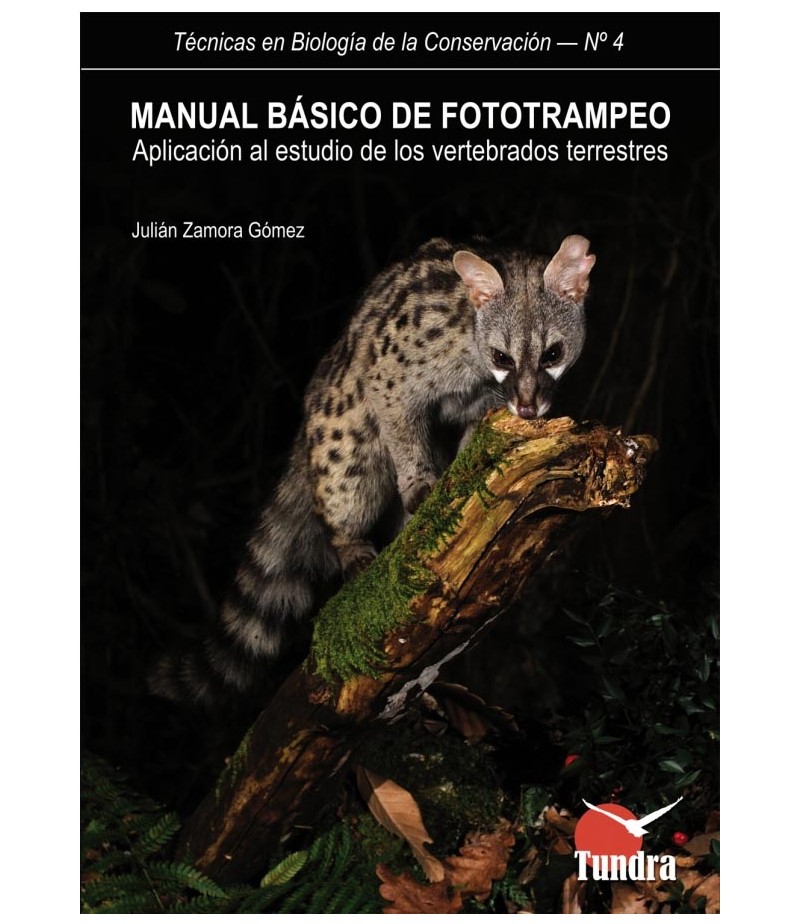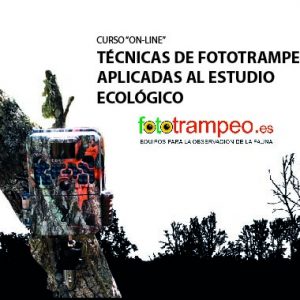Descripción
IMPORTANTE: EL ENVÍO SE HACE POR CORREO POSTAL, NO POR MENSAJERÍA
Editorial: Tundra Ediciones.
Colección: Técnicas en Biología de la Conservación nº 4
Autor: Julián Zamora Gómez (fototrampeo.es)
Formato: 24X17 cm
92 páginas
Rústica
Numerosos esquemas y fotografías B/N
La detección, identificación y estudio de los vertebrados terrestres más difíciles de avistar por su rareza, hábitos huidizos u horarios de actividad nocturnos, entre los que se encuentran gran parte de los mamíferos, dieron un importante salto hacia adelante gracias al desarrollo de las técnicas de fototrampeo mediante el uso de cámaras fotográficas y de video adaptadas para dejar en el campo y autoaccionarse al paso de los animales. Actualmente, con la revolución de la fotografía digital y la aparición de modernos equipos diseñados a propósito, el empleo del fototrampeo se ha extendido notablemente, a la vez que se ha ido afinando la comprensión de la extensa gama de datos e información que se puede obtener, ampliando así el abanico de usos y utilidades.
Pero faltaba un manual práctico sobre esta técnica para hacerla más accesible para la comunidad hispanohablante, un hueco que ahora cubre esta obra, en la que el autor, en lenguaje cercano y claro, describe los orígenes del fototrampeo, los equipos actuales, características de los mismos, usos y recomendaciones para elegir acertadamente el equipo según nuestros objetivos y necesidades; las aplicaciones del fototrampeo para el estudio de la fauna, desde la simple detección de especies a los inventarios, seguimiento de poblaciones y de procesos, estudios de comportamiento, vigilancia, etc. Se exponen también los factores a tener en cuenta para la instalación del equipo en el campo, el uso de cebos, olores y otros atrayentes o el seguimiento de las capturas de imágenes y sistematización y tratamiento de la información. Se extiende también sobre el estudio de las poblaciones de fauna mediante fototrampeo, explicando los conceptos básicos sobre distribución y unidades de muestreo, las metodologías de censo y utilización de estadísticos aplicables a los resultados, así como las recomendaciones para el desarrollo eficaz de las campañas de fototrampeo; todo ello ilustrado con ejemplos reales, tanto de España como de Latinoamérica.
Este manual está dirigido a biólogos, zoólogos, ecólogos, ambientólogos, técnicos y gestores de biodiversidad, espacios protegidos y recursos naturales; a consultores ambientales, guardaparques, agentes forestales y medioambientales, así como a estudiantes de estas materias y a naturalistas, conservacionistas, fotógrafos de naturaleza y demás personas interesadas en el estudio, gestión y conservación de los vertebrados terrestres, o bien, sencillamente, en su observación, detección, fotografía e identificación.
ÍNDICE
Capítulo 1
INTRODUCCIÓN
Capítulo 2
LOS ORIGENES DE ESTA TÉCNICA
Capítulo 3
LOS EQUIPOS DE FOTOTRAMPEO
3.1 Sensores de movimiento
3.2 Velocidad de disparo
3.3 Tiempo de recuperación
3.4 Número de disparos
3.5 Iluminación
3.6 Memoria de almacenamiento
3.7 Baterías
3.8 Tamaño y peso de los equipos
3.9 Resolución de la imagen y del video
3.10 Puntero láser
3.11 Visores y pantallas incorporadas
3.12 Soluciones antirrobo: cajas metálicas, cables de fijación,
pintura de camuflaje, etc
3.13 Información en las imágenes
3.14 Programador del disparo o time lapse
3.15 Envío de imágenes por telefonía móvil
3.16 El firmware
Capítulo 4
COMO ELEGIR UNA CÁMARA DE FOTOTRAMPEO
Capítulo 5
APLICACIONES DEL FOTOTRAMPEO
PARA EL ESTUDIO DE LA FAUNA
5.1 Observación de la fauna
5.2 Inventarios faunísticos o relevamientos
5.3 Seguimiento de poblaciones
5.4 Vigilancia y control furtivismo
5.5 Estudios de comportamiento
5.6 Ver procesos que se desarrollan lentamente mediante time lapse
5.7 La colocación en campo
5.7.1 Los rastros e indicios
5.7.2 Lugares frecuentados por la fauna
5.7.3 Formas de colocación
5.8 Cebos, olores y atrayentes
5.9 Seguimiento de las capturas, sistematización de la información,
tratamiento de las imágenes
Capítulo 6
EL ESTUDIO DE LAS POBLACIONES FAUNÍSTICAS
MEDIANTE FOTOTRAMPEO
6.1 Conceptos básicos de ecología
6.1.1 Distribución de los vertebrados en el espacio
6.1.2 Distribución de los vertebrados en el tiempo
6.1.3 Definición de unidades de muestreo
6.2 Metodologías de censo, utilización de estadísticos y estimas
6.3 Desarrollo de una campaña de fototrampeo
Capítulo 7
BIBLIOGRAFÍA ESENCIAL


